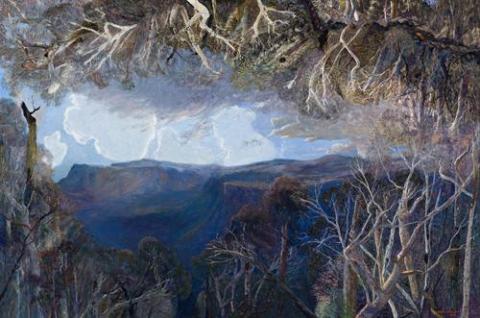TO BEECHMONT WITH STORM CLOUDS BUILDING, 2002
William Robinson
oil on linen
122.0 x 183.0 cm
signed and dated lower right: William Robinson 2002 dated and inscribed verso: 2002 TO BEECHMONT WITH STORM CLOUDS BUILDING
Australian Galleries, Sydney
Private collection, Sydney
Recent Paintings, Australian Galleries, Sydney, 13 August - 7 September 2002, cat.8 (illus.) (label attached verso)
...To see one of Robinson's landscapes is to be in it as well, to walk, and maybe to forage, with the painter through gum-thicketed gullies where any difference between the sky and its reflection is hard to tell- and probably unnecessary to know. The viewer is required to take a leap of faith, and execute something akin to a cartwheel, before penetrating Robinson's dizzy realms. The resulting experience is partly aesthetic, partly athletic...'1
With its multiple viewpoints and sweeping panorama of darkness and light, earth and air, To Beechmont with Storm Clouds Building 2002 encapsulates well the highly original landscapes for which William Robinson has become so widely acclaimed and admired. Departing from predecessors such as Streeton, Drysdale and Williams who focused their attention inland or inward to urban landscapes, Robinson is unique in his devotion to an environment hitherto neglected by artists- the ancient, labyrinthine rainforests of his immediate surroundings in the coastal hinterland of Southern Queensland and northern New South Wales. Similarly, where the Australian landscape tradition had been characterised by a strong horizontality, Robinson here deliberately eschews established figure-ground relationships and conventional one-point perspective to transform landscape into a multi-view experience- allowing every fold and fissure to be explored, yet still preserving a sense of panoramic continuity.
Immortalising those elements of nature which seem eternal- from the stormy clouds, mysterious in their gauzy substance to the endless forest, teeming with life- To Beechmont with Storm Clouds Building continues the artist's enduring interest in the relationship between man and the cosmos. Imbued with a sense of joy and wonderment, it is a homage to the universe and its benevolent creator, celebrating the infinite cycles of nature and the forest as a repository for hope.
1. James, B., A Landscape We Thought We Knew, Sydney Morning Herald, 29 January 2003, p.15
VERONICA ANGELATOS
